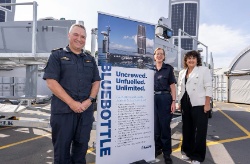Poor drug labelling a recipe for disaster
Poor drug labelling a recipe for disaster
Drug errors may occur as frequently as one in every 133 anaesthetics although the true incidence is likely greater, says Melbourne anaesthetist Dr David Bramley, who is calling for mandatory drug labelling standards to help prevent mistakes resulting from medication packaging.
“Medication use is associated with more errors and adverse events than any other aspect of healthcare,” said Dr Bramley, the Deputy Director of Anaesthesia and Pain Medicine at Western Health, who has written about his concerns in the latest edition of the ANZCA Bulletin.
“Variable drug packaging and look-alike drugs pose particular challenges for anaesthetists working in high-stress situations.”
Some recent examples of similarly labelled drugs include:
• Oxytocin, which has the potential to terminate a pregnancy if mistaken for neostigmine, which is used to safely reverse the effect of an anaesthetic.
• Heparin which may cause life-threatening surgical bleeding if mistaken for ephedrine, used to increase blood pressure.
• Atracurium that could lead to awake paralysis and death if mistaken for midazolam, which reduces anxiety.
“Time pressure, cognitive overload and distraction, coupled with look-alike drugs is a recipe for disaster,” he said.
“Fortunately the meticulous training of anaesthetists to manage medical emergencies and the fact that incidents usually occur in the vicinity of an operating theatre prevents a number of more serious outcomes.”
In January, Western Health submitted a report, endorsed by ANZCA, to the Therapeutic Goods Administration (TGA) that documented medication errors across Victoria involving neuromuscular blocking agents. These medications paralyse patients, leaving them unable to move or breathe, whilst remaining fully conscious, and place them at risk of serious psychological trauma or death if administered accidentally.
The TGA is reviewing literature in relation to the proposals in the report to standardise packaging and presentation of these drugs but is yet to respond formally.
“We are starting with these high-risk neuromuscular drugs with the aim of expanding mandatory drug labelling standards more widely,” Dr Bramley says.
Whilst anaesthetic practice is particularly vulnerable, harm resulting from look-alike packaging poses a risk in any setting in which medications are administered, by either healthcare workers or patients.
Another Melbourne anaesthetist, Dr Nicholas Chrimes, is co-ordinating a global campaign called EZdrugID involving paramedics, doctors and nurses across multiple specialties, as well as members of the public. The campaign is calling for mandatory national standards for the design of pharmaceutical packaging.
A survey conducted in conjunction with the EZDrugID campaign revealed that more than 75 per cent of participating clinicians had experienced a “near miss” attributed
to medication packaging.
ENDS


 Gordon Campbell: On Why The US Stands To Lose The Tariff Wars
Gordon Campbell: On Why The US Stands To Lose The Tariff Wars Te Pāti Māori: Ngarewa-Packer - Fast-Tracking Seabed Mining Ignores Māori Opposition And Environmental Precedent
Te Pāti Māori: Ngarewa-Packer - Fast-Tracking Seabed Mining Ignores Māori Opposition And Environmental Precedent New Zealand Defence Force: Defence And Customs Strengthen Maritime Security With Uncrewed Surface Vessels
New Zealand Defence Force: Defence And Customs Strengthen Maritime Security With Uncrewed Surface Vessels SPCA: Huge Win With New Dog Tethering Regulations
SPCA: Huge Win With New Dog Tethering Regulations Community Housing Aotearoa: Ngā Wharerau o Aotearoa Says New Partnership Model Helping Ensure Right To A Decent Home Is Realised
Community Housing Aotearoa: Ngā Wharerau o Aotearoa Says New Partnership Model Helping Ensure Right To A Decent Home Is Realised Greenpeace Aotearoa: Babies At Risk Due To Nitrate-Contaminated Drinking Water In Ashburton District
Greenpeace Aotearoa: Babies At Risk Due To Nitrate-Contaminated Drinking Water In Ashburton District Driving Change Network: Response To Government’s Proposed Driver Licensing Changes
Driving Change Network: Response To Government’s Proposed Driver Licensing Changes


